Why Aren’t Racehorses Getting Faster?
Humans have been getting progressively bigger, faster, and stronger. Not so horses.
FiveThirtyEight’s Benjamin Harris declares, “American Pharoah’s A Superhorse, But He’s No Secretariat.” His sole basis for making the comparison is their relative performance in the Belmont Stakes:
Picture how far ahead of the field American Pharoah was at the end of the Belmont. Now double it (multiply by 2.4 to be exact). That’s about how far American Pharoah would have been lagging behind Secretariat (13 ¼ lengths). In a Belmont field featuring the 11 Triple Crown winners running their Belmont-winning times, Secretariat would have led the other horses by the following distances:
Presuming that time running twelve furlongs is the best measure of how “super” a racehorse is, that’s pretty compelling. But something else stands out to me from the comparison: the fact that horses—at least those running at the prestigious Belmont—haven’t gotten faster over the last several decades. Not only is the 1973 winner faster than the three subsequent winners–including the horse who won the race 42 years later—but horses that won the race in the 1930s and 1940s are faster than one who won in 1977.
By contrast, human beings have gotten progressively faster over the years.
Usain Bolt, winner of the 100 meter dash in the 2012 Olympics, finished the race some 12 meters ahead of Frank Jarvis, the top finisher in 1900, and 20 meters ahead of Thomas Burke, who won the race in 1896. Indeed, it’s rare to find an instance where a winner was slower than any winner from a previous Olympiad. Moreover, today’s women athletes are faster than the best men of a few decades ago. The top women sprinters are significantly faster than the legendary Jim Thorpe, much less the men from the turn of the 20th century.*
The same is true of virtually every human sport. At virtually every distance, today’s athletes are light years better than their predecessors and today’s women have lapped yesterdays’ men.
Why isn’t the same thing happening in horse racing? If anything, given decades of selective breeding of champions to champions—something that happens only by happenstance among humans—one would think that “superhorses” would be more common than ever.
_____________
*The original version of the post claimed that women had surpassed Jesse Owens’ marks from the 1936 Olympics; they haven’t.
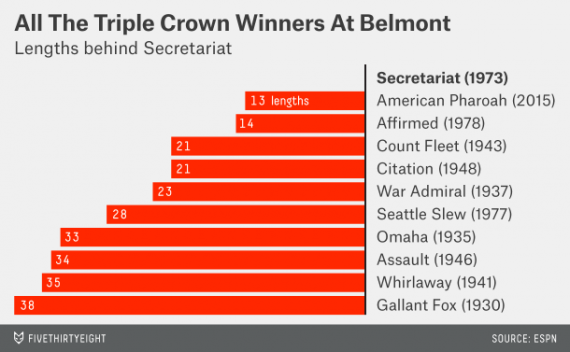

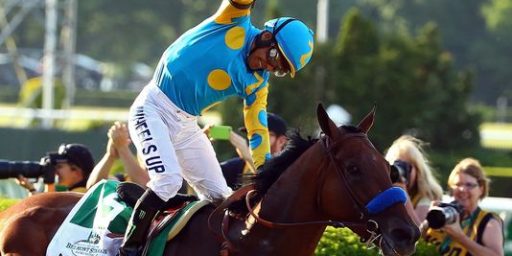
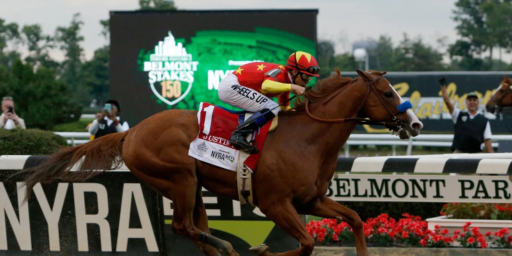
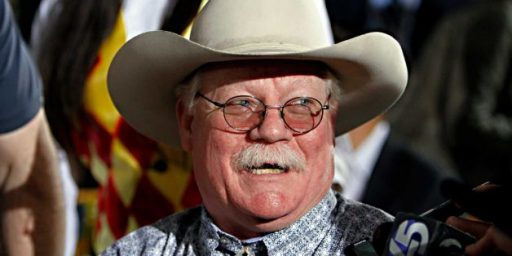

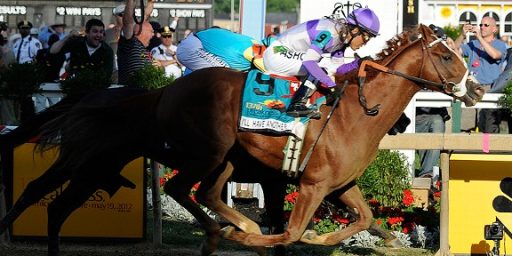
Yes, but is that because Usain Bolt is faster than Frank Jarvis, or because Usain Bolt had starting blocks and a modern Tartan Track running surface?
Perhaps it’s because humans understand the purpose directly, while horses get it second-hand. Our motivation is our own, not imparted by another species we only foggily comprehend.
Still, even then, one would think the kind of selective breeding we’ve learned to do would mean a Triple Crown winner every couple years, but we had to wait 37.
Just a guess but horses are bred for speed while humans aren’t. Selective breeding can be an effective way of getting the traits you want but it also narrows the pool from which future traits will be selected. It might be that thoroughbred horses have reached a dead end.
Why don’t horses run faster? Compensation.
What does Usain Bolt get? Millions of dollars in endorsement deals and pretty much any woman he wants.
What does Pharaoh get? The same damn oats he’s always had and some stablehand sticking a hairy arm up his ass to force him to ejaculate joylessly into a horsey version of a Fleshlight.
@michael reynolds:
As I mentioned in the previous thread, thoroughbreds aren’t allowed to use AI. They can’t be registered unless the were conceived the natural way.
@Stormy Dragon:
I did not know that. Thanks for using “facts” to ruin a perfectly good joke.
Lousy facts.
@Dave Schuler:
Two or three generations of non-selective breeding are not going to lead to a significant change in biology. Evolution doesn’t work that quickly. The difference between Frank Jarvis and Usain Bolt has nothing to do with biology; it’s entirely equipment and training technique.
Which is why horse racing hasn’t gotten faster: you can’t teach a horse to crouch in the starting stall in an entirely unnatural fashion because scientists have determined it’s the mechanically optimal way to launch into the race. You can get Usain Bolt to do that because he can comprehend very precise descriptions of what he should do and why.
We’re looking at performance engines, so let’s look at performance. It is possible that the animals are at or near peak while the human is still on an improving path.
I’ve seen kinesiologists make the opposite argument for elite baseball pitchers. We’ve apparently just been bumping the ceiling of performance in that task as allowed by the biological mechanics. After a certain level, weights, diet, training and technique have done all they can do to continue the performance.
Selective breeding arguments could probably go either way in this as a lay debate, I’d suppose.
@michael reynolds:
There are other types of horses where AI is common (e.g. standardbred horses). The live cover requirement is one of the peculiarities of thoroughbred racing.
Um, no. World record 100m women, 10.49 seconds.
Jesse Owen’s 100m time: 10.2 seconds.
World record 200m women, 21.34 seconds
Jesse Owen’s 200m time: 20.7 seconds
Took about a minute on Google.
Sure, if by a few you mean about eight decades.
Times are getting faster for both men and women, but a lot of that is because of starting blocks (didn’t have those), much faster tracks (engineered to bounce in time with human runners), better shoes, and of course, various supplements.
@george:
Interesting article on the evolution of starting blocks:
Track and Field Starting Blocks Evolution
Even since 1972 they’ve changed significantly; modern starting blocks are more akin to a swimming starting block: a angled platform the runner is crouched on to let them launch themselves superman style into the beginning of the race.
Secretariat was a freak of nature. I worked on the film “Secretariat” and know more about that horse than I should.
That horse, at three years old, racing against other three year olds, was the equivalent of Usain Bolt, at his peak, racing against good high school sprinters. There will probably never be another horse like Secretariat again.
Facts: He broke the records at the Kentucky Derby, Preakness, and Belmont. All those records still stand today. Never done before.
In the Kentucky Derby that year, Secretariat ran every quarter mile faster than the previous one, with the final quarter at 23 seconds. Before Secretariat, no horse had ever broken 2 minutes in the Kentucky Derby. His record still stands.
Secretariat had the largest heart ever seen in a thoroughbred. It was about 22 pounds, well over twice the size of a normal heart in a horse.
He was a freak of nature.
@george: You’re right. I was going from memory—I’ve written on the men/women aspect before. While Jim Thorpe’s decathalon figures have been bested by the best female heptathletes, Owens’ spring and long jump records still easily outpace any woman.
@Stormy Dragon:
Thoroughbred horses’ lineages go back to the 17th century and all modern thoroughbreds are descended from just three stallions. That’s enough to breed variety out.
I just assumed it was because secretariat was on a heavy diet of steroids and methamphetamines.
Part of the reason why thoroughbreds aren’t running the Belmont any faster is because we have bred away from that stamina line towards more “speed” as it is called – the ability to run shorter distances. The Belmont’s 1 1/2 mile is a rare distance today, but it used to be quite common. Most races have been shortened to 1 1/4 mile or less.
@Stormy Dragon:
No, but there have been a lot of equipment and track surface changes since the 50s, so times from the 70s or 80s on are typically faster than they were before then.
@teve tory: That’s what I thought, too.
One other thing: If a horse doesn’t need to break a track record to win a race, there’s no motivation for them to do so. Their owners don’t get more money if they break a track record while winning, and most trainers would be very upset with a jockey who won by 31 lengths the way Secretariat did in 1973. Why run faster than you have to?
I was hoping someone with expertise in evolutionary biology would ring in. However, I think commenters above have hit the major points, short time period and exceedingly small gene pool.
Interestingly, race horses are one of the examples Darwin used in The Origin of Species. Darwin, as the story goes, was reluctant to publish. Amongst other reasons was that his wife was quite religious and would find it disturbing that he would push something she might see as anti-religion. So he set out to make his argument such that she might see the conclusion as inevitable, something he was compelled to accept, not willful irreverence.
He used race horses as a well known example of how selection by breeders for speed could drive change in thoroughbreds. Racehorses did become progressively faster for a long time. He then advanced the theory of “natural selection”, that natural processes could select for adaptive traits much like breeder selection. He ended up with a remarkable book. Biology and philosophy aside, it’s worth reading for the example of how to craft a compelling argument.
@Kari Q: Yes, this. The jockey should be standing up long before the finish line if the horse is running away with the race.
Training is important too. Horses just cannot spend time in the film room the way human athletes do.
@Kari Q: Exactly. Because pushing a horse to greater speed than needed to secure the win can result in the kind of injuries that saw a horse put down for broken ankles during a previous Triple Crown race.
To some extent we’ve reached a limit on breeding for speed. The longer thinner legs that contribute to that also lead to greater tendency toward career (and for horses) life ending injury. However the breeder who made the investment in trying to introduce more stamina and structural strength in his or her stock would have to be able to afford losing races for several generations of stock before anything like a Secretariat would be produced, and even then it’s a gamble.
Can’t say whether horses are not getting faster- I can say that using Triple Crowns winners which include 20 and 30 something year long gaps is bad sampling.
@Dave Schuler: That sounds like the “we’ve already got to the limits of this genetic line.”
Plus, I bet historically fast horses were considered more important than fast humans. We’ve been breeding for fast horses throughout history.